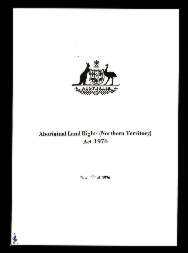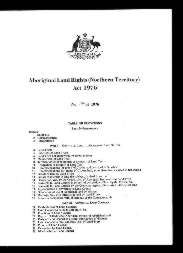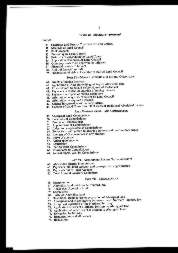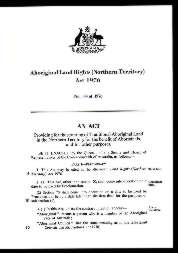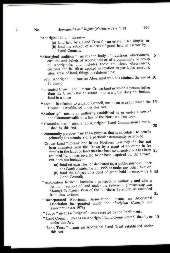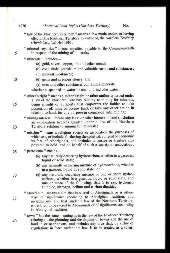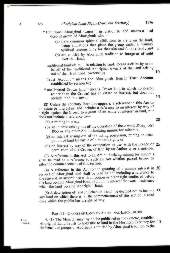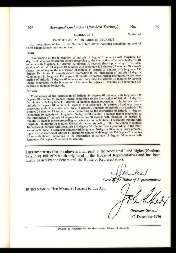

Aboriginal Land Rights (Northern Territory) Act 1976 (Cth)
Significance
This document, signed by the Governor-General on 16 December 1976, established the basis upon which Aboriginal people in the Northern Territory could, for the first time, claim rights to land based on traditional occupation. This Act was the first Australian law which allowed a claim of title if claimants could provide evidence of their traditional association with land. The first State legislation, the South Australian Pitjantjatjara Lands Act 20 years before, transferred land to the Pitjantjatjara people but did not provide a basis for claims by other groups.Claims under the Northern Territory Act were limited to land not already alienated. Schedule 1 to the Act lists all unalienated Crown land in the Territory under district headings (Amoonguna, Arnhem Land (Islands), Arnhem Land (mainland), Bathurst Island, Beswick, Daly River, Delissaville, Haasts Bluff, Hermannsburg, Hooker Creek, Jay Creek, Lake Mackay, Larrakeah, Melville Island, Petermann, Santa Teresa, Wagait, Warrabri, Woolwonga and Yuendumu). Schedule 2 concerns the Ranger Project Area and Schedule 3 concerns the Eastern Areas on Groote Eylandt.
The Act specified a 20-year period for claims to be lodged, which closed in 1997.
History
The policy of assimilation of Aboriginal people into European society was introduced in 1939 and implemented vigorously under Paul Hasluck as Minister from 1951 to 1963. In 1962 Aboriginal people finally won voting rights for Commonwealth and Territory elections. Two years later the Northern Territory Welfare Ordinance was replaced by a comprehensive social welfare Ordinance that lifted all major restrictions on Aboriginal people. The 1967 referendum removed the constitutional barrier to the Commonwealth Government's power to legislate for all Indigenous people.Organised Aboriginal protest against poor living and working conditions on cattle stations began at Newcastle Waters in 1966 and continued at Wave Hill from 1968. In 1963 Yolngu people at Yirrkala sent petitions to Parliament to protest the excision of more than 300 square kilometres of their land for bauxite mining. Their battle was lost in the Northern Territory Supreme Court decision in Gove Land Rights case eight years later, with judgment against them.
Aboriginal protests continued and with growing public support, the McMahon Government reviewed Commonwealth policy, putting out a statement in January 1971 that retreated considerably from the direct assimilation policy. This statement acknowledged specifically that Aboriginal people 'should be encouraged and assisted to preserve and develop their own culture, language, traditions and arts so that these can become living elements in the diverse culture of Australian society'.
The succeeding Whitlam Government promised 'self-determination in economic, social and political affairs'. Whitlam's early fall from power left the Coalition government led by Malcolm Fraser to announce a policy of 'self-management' and in 1976, to pass this Act.
The Act contains notable inequities; for instance, claims could be made to unalienated Crown land (until the terminating date of June 1997) only on the basis of 'traditional ownership', disadvantaging those most disrupted by European occupation who are least able to provide evidence of continuing traditional association. Nevertheless the Act was a milestone of Aboriginal advancement in Australia in the second half of the 20th century.
Description
| Long Title: | An Act providing for the granting of Traditional Aboriginal Land in the Northern Territory for the benefit of Aboriginals, and for other purposes. (No. 191 of 1976) |
| No. of pages: | 46 + cover |
| Medium: | Paper, stiff cover |
| Measurements: | 24 x 17 cm |
| Provenance: | House of Representatives |
| Features: | Signatures on p.45 |
| Location & Copyright: | National Archives of Australia |
| Reference: | NAA: A1559/1, 1976/191 |
